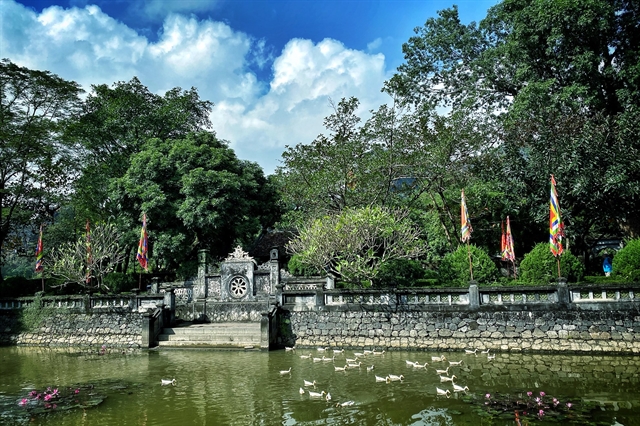

The province of Ninh Bình is this year’s host to the National Tourism Year programme. Its history goes back to the Tenth Century Kingdom of Đại Việt.

|
| HISTORY RESONATES: The Hoa Lư temple, built in the 17th century houses worshipping temples for King Đinh Tiên Hoàng and King Lê Hoàn. VNS Photo Việt Thanh |
by Nguyễn Mỹ Hà
The magnificent province of Ninh Bình, home to winding water flows among beautiful karsts, rice fields and lotus swamps, the natural studio for the blockbuster Kong: Skull Island is now back in the national spotlight.
This year the province will host the National Tourism Year programme, initiated by the Ministry of Culture, Sports and Tourism.
Home to the first independent kingdom of Đại Việt in the 10th century, Hoa Lư the royal capital features as the theme of Ninh Bình Tourism Year.
'Hoa Lư, the thousand-year-old royal capital' will shine through the year as the meeting point of international and local travellers.
Destinations for everyone
Located only two hours by car from Hà Nội, Ninh Bình draws both international and local tourists. A visit to Việt Nam's ancient capital of Hoa Lư is a must for students to pay tribute to the ancient kingdom as well as learn their history.
For high school students, the spectacular mountains and river background provide a stunning backdrop for yearbook and graduation photos.
In the early days of 2020, we made a trip to Hoa Lư, where the young woman at the ticket booth said they sold an average of 1,000 tickets per day.
"You are standing on the ground of the former treasury of King Đinh Tiên Hoàng," said Lê Văn Tiên, 58, a local motorbike taxi driver-turned-tour guide.
"In 968, when King Đinh Tiên Hoàng founded our first independent kingdom named Đại Cồ Việt known as the Reign of Peace, he ordered the treasury be built here to store money coins, gold and food supplies to build the royal citadel," Tiên said as he pointed around the valley, which is surrounded by mountains.
Legend has it that the king had to ride a horse to get down to the treasury. There weren't any roads like today.
He went on to say that in 1010 when King Lý Thái Tổ decided to move the capital to the larger Đại La citadel on a larger area of flat land, a pagoda was built on the ground of the former treasury and named Kim Ngân Tự, which means Treasury Pagoda.
On the premises of the pagoda when we visited, a rare grapefruit tree was bearing more than 100 ripe fruits, which created an aura of prosperity during a special time as Tết, or Lunar New Year is just around the corner.
Most visitors who come to Hoa Lư only see the main worshipping altar to King Đinh Tiên Hoàng, King Lê Hoàn and his Queen Dương Vân Nga.
Ancient stone beds were used as altars for royal ceremonies. Within the small gardens of the complex, you can hear English, French, Russian, Korean, Chinese, and of course Vietnamese.
A couple from the Netherlands told Việt Nam News this was their third time to Việt Nam.
"This is my first trip to Ninh Bình," Julia van Bracht said. "I like the mountains and rivers, it’s very nice. Fifteen years ago, I travelled from north to south: Hạ Long Bay, Sa Pa, Huế, Hội An, Nha Trang, Mũi Né."
"Seven years ago, I came back with my husband."
Her husband picked up from where she left off.
"We came here because of interesting people, culture, good weather, good food. It’s lovely to be here. I feel quite comfortable to be here. No stress. It’s touristic, but not too much. I like it the way it is now. It’s quite authentic."
Masterplan
In a meeting to announce Ninh Bình would host National Tourism Year 2020, Minister of Culture, Sports and Tourism Nguyễn Ngọc Thiện said that many provinces have boosted tourism by hosting the programme. He added that it would also be a boon for the local economy and job creation.
"You need to take this opportunity to push tourism to Ninh Bình further up," he said.
He urged the provincial People's Committee Chairman Đinh Văn Điến to work with neighbouring provinces to offer diverse experiences for tourists.
From 2010 until 2018, the number of tourists visiting Ninh Bình increased by 12 per cent each year, with revenue from tourism up by 25 per cent annually.
In 2018 alone, there were 7.4 million visitors, bringing in a total revenue of VNĐ3.2 trillion (US$139 million) to a province with the country's 44th biggest population at 1.12 million people.
According to chairman Điến, Ninh Bình has become a popular spiritual destination for local tourists, who pay tribute at many local pagodas. But Ninh Bình's accommodation capacity is a maximum of 8 to 10 million visitors a year.
Provinces typically use National Tourism Year to attract more visitors, but this is not the case for Ninh Bình. The province has long been a magnet for tourists, its only problem is how to ensure they don't all go to Ninh Bình at the same time of year.
This month, after Tết (Lunar New Year) holiday, thousands of local pilgrims will visit many pagodas in Ninh Bình, so tours channels need to be arranged to avoid congestion and overcrowding.
Several festivals will take place in Ninh Bình this year, including Tourism Year's opening ceremony in February, Bái Đính Pagoda festival, Hoa Lư, ancient capital festival, Tràng An festival, the Golden Week of Tam Cốc - Tràng An for the rice harvesting time and more. Other events will take place around the year and in 16 other cities and provinces.
The chairman of the Administration of Tourism, Nguyễn Trùng Khánh, confirmed its complete support for Ninh Bình and promised to fund public campaign to promote the province at international tourism fairs.
Excuse me? Sunbathing on a beach in Ninh Bình?
Bùi Thành Đông, head of the Tourism Department of Ninh Bình, has announced that work has been implemented so that visitors can enjoy the province's beautiful beaches.
With 3,000 km of coast, Việt Nam has many popular beaches from north to south, but Ninh Bình has never been seen as a place for a beach getaway.
For the first time, the province has invested in accommodation facilities to host guests to its beach on Cồn Nổi, or floating island, in Kim Sơn District.
"We have worked out a masterplan, in which tourism in Ninh Bình will reach its peak in 2030, bringing in the major source of income to our province," Đông said.
Making ends meet
During the low season towards the end of the lunar year, a 35-member team of motorbike drivers at Hoa Lư Ancient Kings' tombs make ends meet by driving elderly people around to visit six places, including the Treasury Pagoda, Hoa Lư and the most ancient stone pillar with ancient script, which is now weathered beyond recognition.
A roof had been put on it in 2010, when Hà Nội celebrated its centennial founding anniversary.
"Can you feel the fresh air, the beautiful scenery and the tranquillity of this pagoda," asked Nguyễn Văn Cường, a retired artillery soldier, who spent seven years in the army defending his country. Now he drives guests on his bike to tour the historic places of his home.
"What more can I expect as a retired armyman, showing people from all over the world our beautiful home, and making ends meet from it."
Definitely so, but only during the low season, when only about 1,000 people visit Hoa Lư a day, but not later this month, when many buses, cars and motorbikes will bring thousands of people daily.
Perhaps, Ninh Bình health authorities should also put their air quality monitors to work. VNS
GLOSSARY
The magnificent province of Ninh Bình, home to winding water flows among beautiful karsts, rice fields and lotus swamps, the natural studio for the blockbuster Kong: Skull Island is now back in the national spotlight.
Spotlight means “focus”.
This year the province will host the National Tourism Year programme, initiated by the Ministry of Culture, Sports and Tourism.
Initiated means “started”.
Home to the first independent kingdom of Đại Việt in the 10th century, Hoa Lư the royal capital features as the theme of Ninh Bình Tourism Year.
A theme is a subject.
A visit to Việt Nam's ancient capital of Hoa Lư is a must for students to pay tribute to the ancient kingdom as well as learn their history.
To pay tribute means to honour.
"In 968, when King Đinh Tiên Hoàng founded our first independent kingdom named Đại Cồ Việt known as the Reign of Peace, he ordered the treasury be built here to store money coins, gold and food supplies to build the royal citadel," Tiên said as he pointed around the valley, which is surrounded by mountains.
A citadel is a city that is protected from being attacked.
If mountains surround a city, they are all around that city.
Legend has it that the king had to ride a horse to get down to the treasury. There weren't any roads like today.
Legends are traditional stories.
He went on to say that in 1010 when King Lý Thái Tổ decided to move the capital to the larger Đại La citadel on a larger area of flat land, a pagoda was built on the ground of the former treasury and named Kim Ngân Tự, which means Treasury Pagoda.
A treasury is a place where money is kept.
On the premises of the pagoda when we visited, a rare grapefruit tree was bearing more than 100 ripe fruits, which created an aura of prosperity during a special time as Tết, or Lunar New Year is just around the corner.
A premises is a property.
If a type of grapefruit tree is rare, there are not many of them.
An aura is an atmosphere.
Prosperity means wealth.
It’s quite authentic."
Authentic means real.
In a meeting to announce Ninh Bình would host National Tourism Year 2020, Minister of Culture, Sports and Tourism Nguyễn Ngọc Thiện said that many provinces have boosted tourism by hosting the programme.
Boosted means improved.
He added that it would also be a boon for the local economy and job creation.
A boon means a time of doing good business.
"You need to take this opportunity to push tourism to Ninh Bình further up," he said.
An opportunity is a chance.
He urged the provincial People's Committee Chairman Đinh Văn Điến to work with neighbouring provinces to offer diverse experiences for tourists.
Diverse means different.
The province has long been a magnet for tourists, its only problem is how to ensure they don't all go to Ninh Bình at the same time of year.
A magnet is something that attracts things. In this case, tourists.
This month, after Tết (Lunar New Year) holiday, thousands of local pilgrims will visit many pagodas in Ninh Bình, so tours channels need to be arranged to avoid congestion and overcrowding.
Pilgrims are people who travel for religious purposes.
If there is congestion it is difficult to move because of overcrowding.
Bùi Thành Đông, head of the Tourism Department of Ninh Bình, has announced that work has been implemented so that visitors can enjoy the province's beautiful beaches.
Implemented means “put in place”.
"Can you feel the fresh air, the beautiful scenery and the tranquillity of this pagoda," asked Nguyễn Văn Cường, a retired artillery soldier, who spent seven years in the army defending his country. Now he drives guests on his bike to tour the historic places of his home.
Tranquillity means peacefulness.
Perhaps, Ninh Bình health authorities should also put their air quality monitors to work.
Air quality monitors are devices that test whether the air is clean or not.
WORKSHEET
Find words that mean the following in the Word Search:
a | f | i | e | l | h | o | u | r | s |
n | l | r | d | e | a | u | y | n | y |
c | s | a | e | f | d | f | t | g | a |
i | q | t | o | n | c | u | r | l | l |
e | p | o | h | o | c | s | e | i | t |
n | r | d | o | f | l | h | r | s | a |
t | b | c | o | f | f | e | e | h | r |
h | o | r | s | e | r | s | t | j | b |
ANSWERS: 1. French; 2 .Horse; 3. Hours; 4. Ancient; 5. Altar.




